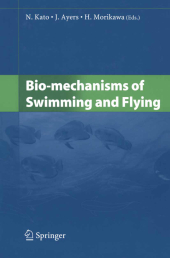 Neuerscheinungen 2012Stand: 2020-01-07 |
Schnellsuche
ISBN/Stichwort/Autor
|
Herderstraße 10
10625 Berlin
Tel.: 030 315 714 16
Fax 030 315 714 14
info@buchspektrum.de |

J. Ayers, N. Kato, H. Morikawa
(Beteiligte)
Bio-mechanisms of Swimming and Flying
Herausgegeben von Kato, N.; Ayers, J.; Morikawa, H.
Softcover reprint of the original 1st ed. 2004. 2012. x, 210 S. X, 210 p. 235 mm
Verlag/Jahr: SPRINGER, BERLIN; SPRINGER JAPAN 2012
ISBN: 4-431-67963-4 (4431679634)
Neue ISBN: 978-4-431-67963-9 (9784431679639)
Preis und Lieferzeit: Bitte klicken
Tens of thousands of different animal species live on this planet, having survived for millions of years through adaptation and evolution, which has given them a vast variety of structures and functions. Biomechanical studies of animals swimming and flying can aid understanding of the mechanisms that enable them to move effectively and efficiently in fluids . Based on such understandings and analyses, we can aim to develop environmentally friendly machines that emulate these natu ral movements. The Earth Summit in Rio de Janeiro in 1992 agreed major treaties on biological diversity, addressing the comb ined issues of environmental protection and fair and equitable economic development. With regard to coastal environments, increasing biological diversity has begun to play an important role in reestablishing stable and sustainable ecosystems. This approach has begun to influence research into the behavior of aquatic species, as an understanding of the history of an individual aquatic species is indispensable in constructing an environmental assessment mod el that includes the physical, chemical, and biological effects of that species . From an engineering viewpoint, studying nature´s biological diversity is an opportunity to reconsider mechanical systems that were systematically constructed in the wake of the Industrial Revolution. We have been accumulating knowledge of the sys tems inherent in biological creatures and using that knowledge to create new, envi ronmentally friendly technologies.
Chapter 1: An Engineering Perspective on Swimming Bacteria: High-Speed Flagellar Motor, Intelligent Flagellar Filaments, and Skillful Swimming in Viscous Environments, Y. Magariyama, S. Kudo, T. Goto, and Y. Takano.- Chapter 2: Euglena Motion Control by Local Illumination, A. Itoh.- Chapter 3: Thrust-Force Characteristics of Enlarged Propulsion Mechanisms Modeled on Eukaryotic Flagellar Movement and Ciliary Movement in Fluid, S. Kobayashi, K. Furihata, T. Mashima, and H. Morikawa.- Chapter 4: Resonance Model of the Indirect Flight Mechanism, H. Miyake.- Chapter 5: On Flow Separation Control by Means of Flapping Wings, K.D. Jones, M. Nakashima, C.J. Bradshaw, J. Papadopoulos, and M.F. Platzer.- Chapter 6: Outboard Propulsor with an Oscillating Horizontal Fin, H. Morikawa, A. Hiraki, S. Kobayashi, and Y. Muguruma.- Chapter 7: Three-Dimensional Maneuverability of the Dolphin Robot (Roll Control and Loop-the-Loop Motion), M. Nakashima, Y. Takahashi, T. Tsubaki, and K. Ono.- Chapter 8: Fundamental Study of a Fishllike Body with Two Undulating Side-Fins, Y. Toda, T. Suzuki, S. Uto, and N. Tanaka.- Chapter 9: Biology-Inspired Precision Maneuvering of Underwater Vehicles, N. Kato, H. Liu, and H. Morikawa .- Chapter 10: Optimal Measurement Strategies for Environmental Mapping and Localization of a Biomimetic Autonomous Underwater Vehicle, J. Guo, F.-C. Chiu, S.-W. Cheng, and P.-C. Shi.- Chapter 11: Experimental and Analytical Study of the Schooling Motion of Fish Based on Two Observed Individual Motions: Approaching Motion and Parallel Orienting Motion, Y. Inada, K. Kawachi, and H. Liu.- Chapter 12: Neural Basis of Odor-Source Searching Behavior in Insect Microbrain Systems Evaluated with a Mobile Robot, R. Kanzaki, S. Nagasawa, and I. Shimoyama.- Chapter 13: Architectures for Adaptive Behavior in Biomimetic Underwater Robots, J. Ayers.- Chapter 14: Efficiency of Biological and Artificial Gills, K. Nagase, F. Kohori, and K. Sakai.- Subject Index.


